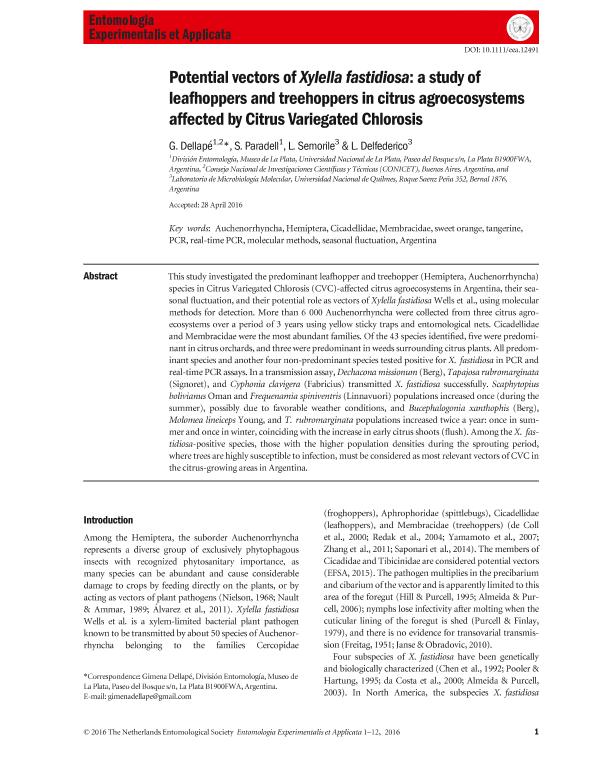Mostrar el registro sencillo del ítem
dc.contributor.author
Dellapé, Gimena

dc.contributor.author
Paradell, Susana Liria

dc.contributor.author
Semorile, Liliana Carmen

dc.contributor.author
Delfederico, Lucrecia

dc.date.available
2018-08-09T18:54:51Z
dc.date.issued
2016-11
dc.identifier.citation
Dellapé, Gimena; Paradell, Susana Liria; Semorile, Liliana Carmen; Delfederico, Lucrecia; Potential vectors of Xylella fastidiosa: a study of leafhoppers and treehoppers in citrus agroecosystems affected by Citrus Variegated Chlorosis; Wiley Blackwell Publishing, Inc; Entomologia Experimentalis et Applicata; 161; 2; 11-2016; 92-103
dc.identifier.issn
0013-8703
dc.identifier.uri
http://hdl.handle.net/11336/54822
dc.description.abstract
This study investigated the predominant leafhopper and treehopper (Hemiptera, Auchenorrhyncha) species in Citrus Variegated Chlorosis (CVC)-affected citrus agroecosystems in Argentina, their seasonal fluctuation, and their potential role as vectors of Xylella fastidiosa Wells et al., using molecular methods for detection. More than 6 000 Auchenorrhyncha were collected from three citrus agroecosystems over a period of 3 years using yellow sticky traps and entomological nets. Cicadellidae and Membracidae were the most abundant families. Of the 43 species identified, five were predominant in citrus orchards, and three were predominant in weeds surrounding citrus plants. All predominant species and another four non-predominant species tested positive for X. fastidiosa in PCR and real-time PCR assays. In a transmission assay, Dechacona missionum (Berg), Tapajosa rubromarginata (Signoret), and Cyphonia clavigera (Fabricius) transmitted X. fastidiosa successfully. Scaphytopius bolivianus Oman and Frequenamia spiniventris (Linnavuori) populations increased once (during the summer), possibly due to favorable weather conditions, and Bucephalogonia xanthophis (Berg), Molomea lineiceps Young, and T. rubromarginata populations increased twice a year: once in summer and once in winter, coinciding with the increase in early citrus shoots (flush). Among the X. fastidiosa-positive species, those with the higher population densities during the sprouting period, where trees are highly susceptible to infection, must be considered as most relevant vectors of CVC in the citrus-growing areas in Argentina.
dc.format
application/pdf
dc.language.iso
eng
dc.publisher
Wiley Blackwell Publishing, Inc

dc.rights
info:eu-repo/semantics/openAccess
dc.rights.uri
https://creativecommons.org/licenses/by-nc-sa/2.5/ar/
dc.subject
Argentina
dc.subject
Auchenorrhyncha
dc.subject
Cicadellidae
dc.subject
Hemiptera
dc.subject
Membracidae
dc.subject
Molecular Methods
dc.subject
Pcr
dc.subject
Real-Time Pcr
dc.subject
Seasonal Fluctuation
dc.subject
Sweet Orange
dc.subject
Tangerine
dc.subject.classification
Otras Ciencias Biológicas

dc.subject.classification
Ciencias Biológicas

dc.subject.classification
CIENCIAS NATURALES Y EXACTAS

dc.title
Potential vectors of Xylella fastidiosa: a study of leafhoppers and treehoppers in citrus agroecosystems affected by Citrus Variegated Chlorosis
dc.type
info:eu-repo/semantics/article
dc.type
info:ar-repo/semantics/artículo
dc.type
info:eu-repo/semantics/publishedVersion
dc.date.updated
2018-08-09T15:19:23Z
dc.journal.volume
161
dc.journal.number
2
dc.journal.pagination
92-103
dc.journal.pais
Reino Unido

dc.journal.ciudad
Londres
dc.description.fil
Fil: Dellapé, Gimena. Universidad Nacional de La Plata. Facultad de Ciencias Naturales y Museo. División Entomología; Argentina. Consejo Nacional de Investigaciones Científicas y Técnicas; Argentina
dc.description.fil
Fil: Paradell, Susana Liria. Universidad Nacional de La Plata. Facultad de Ciencias Naturales y Museo. División Entomología; Argentina
dc.description.fil
Fil: Semorile, Liliana Carmen. Universidad Nacional de Quilmes. Departamento de Ciencia y Tecnología. Laboratorio de Microbiología Molecular; Argentina
dc.description.fil
Fil: Delfederico, Lucrecia. Universidad Nacional de Quilmes. Departamento de Ciencia y Tecnología. Laboratorio de Microbiología Molecular; Argentina. Consejo Nacional de Investigaciones Científicas y Técnicas; Argentina
dc.journal.title
Entomologia Experimentalis et Applicata

dc.relation.alternativeid
info:eu-repo/semantics/altIdentifier/doi/http://dx.doi.org/10.1111/eea.12491
dc.relation.alternativeid
info:eu-repo/semantics/altIdentifier/url/https://onlinelibrary.wiley.com/doi/abs/10.1111/eea.12491
Archivos asociados
